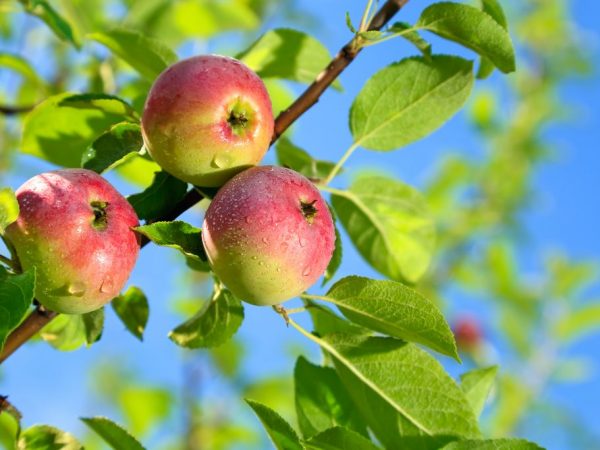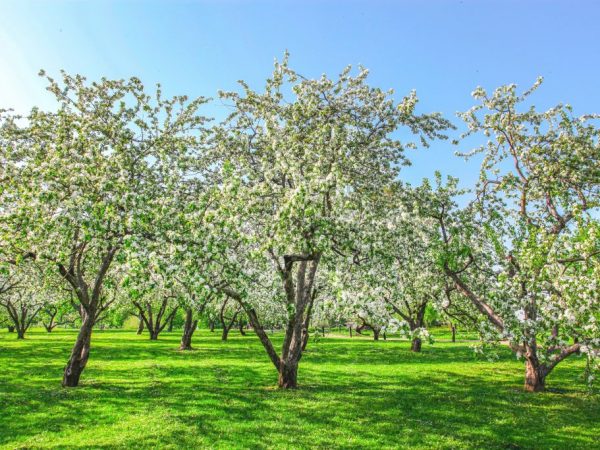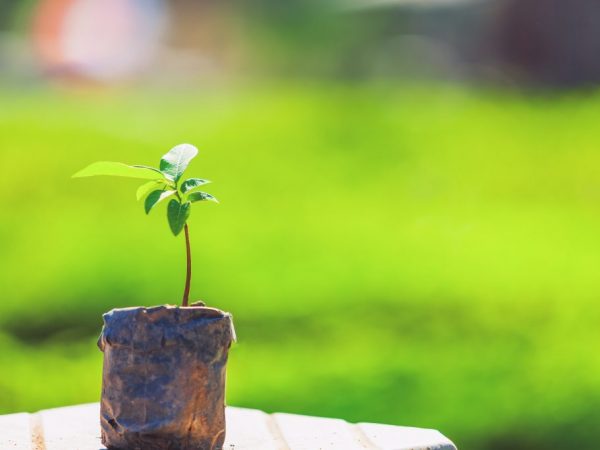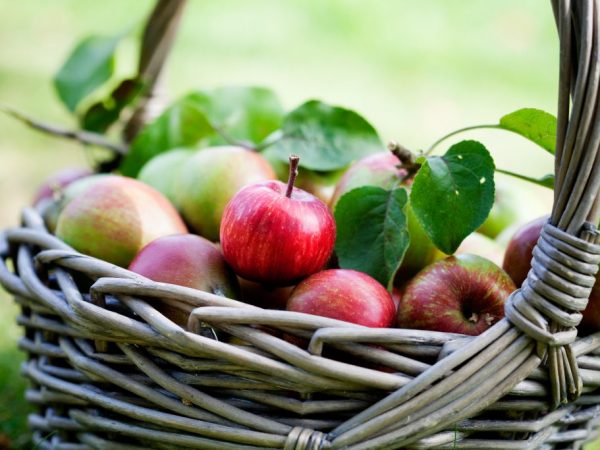Cultivation of an apple tree Elena
The apple tree Elena is a hybrid; it was bred by Belarusian breeders at the beginning of the 21st century. To create were used varieties Discovery and Early Sweet.

Cultivation of an apple tree Elena
Already in the early 2000s, the hatched crop was allowed for mass cultivation. At this time, it is common in Europe in regions with a temperate climate.
general characteristics
The apple variety Elena combines the best qualities of its parents
It is a short and compact crop that does not grow higher than 3 m. The average crown density and its pyramidal shape create an attractive appearance - it fits perfectly into almost any garden landscape.
The foliage plentifully surrounds the edges of the branches, and, reaching the trunk of the tree, gradually decreases in number. The bark has a characteristic gray-green color.
Flowering begins in mid to late spring. Its snow-white flowers emit a thick, rich aroma.
Full maturity of the fruit is characterized by a pinkish blush on the sides. With good care, it can reach 150 g.
Taste rating
The variety of apples Elena is very tasty. Their flesh has a granular structure, it is juicy and aromatic. It contains a high sugar content, which creates a unique flavor bouquet.
The peculiarity of the culture is its short storage time. Fruits quickly lose their taste, become tasteless and dry.
Self-fertility
The positive quality of the variety is bisexual. For pollination, the tree does not require the presence of other representatives of varietal crops nearby.
Pollination occurs due to the large number of insects, which in the spring are attracted by the sweet aroma of the blossoming apple tree.
Yield
The tree bears fruit every year. With good care, the fruits are at their maximum size.
A competent and rational approach to cultivation will allow you to get bountiful harvests of tasty and healthy fruits. The record amount of harvested fruits is up to 25 t / ha.
Winter hardiness
According to the description, the Elena variety is relatively winter-hardy: in temperate climatic zones, apple trees take root without additional measures for caring for them.
Insulation of the root zone of the plant before the winter period is not necessary in this case.
Disease resistance
The apple tree is characterized by resistance to various diseases. At the same time, some fungal diseases, such as powdery mildew, milky shine, are still capable of causing considerable harm to the culture.

The variety is resistant to various diseases
It can also be attacked by scab, especially if trees already infected with it grow nearby.
Landing
In order for the varietal culture you have chosen to quickly take root, and after a short time it begins to delight with its fruits, you should plant it correctly.
Timing
The most favorable time for planting a seedling with an open root system is the beginning of autumn (September - early October).
A young plant will have time to adapt to new conditions and settle down before the arrival of cold weather. With the arrival of spring, the root system will be ready to fill the crop with all the necessary nutrients for its growth and development.
Planting seedlings with a closed root system can be carried out in early spring, before the formation of the first buds (late May - April). After planting, systematic watering is required.
Choosing a landing site
The soil is of great importance. Loamy, humus-rich, but not over-acidified soil is suitable.
The clay area should be loosened, add components to its composition that contribute to sufficient soil ventilation (peat, sand, compost).
Elena can be attributed to moisture-loving varietal plants. But an excess of moisture can lead to decay of the rhizome.
It is recommended to plant in an area where the occurrence of internal groundwater passes at least 2 m before the root system. Otherwise, you should make a ground elevation yourself.
The tree should not be planted in shady areas. The site should be well lit.
Young seedlings should be placed away from mature plants to prevent shading. The distance between the apple trees must be at least 3 m.
Landing technology
Immediately before planting the future apple tree in the chosen place, it must be prepared.
- The planting hole is prepared in advance (7-10 days in advance). The size of the fossa should correspond to the size of the crop rhizome.
- A stake is driven into the middle of the recess so that it protrudes 50-60 cm above the surface of the upper layer.
- The bottom of the hole can be laid out with a small amount of small stones - they will act as a kind of drainage, and prevent excess moisture from stagnating.
- After the formation of a depression, it is immediately filled with a mixture of the left earth and organic fertilizer.
- After the formation of the soil, the hole is filled up, and all subsequent days are kept in this position (7-10). During this time, the soil will settle and settle. You can cover the top with polyethylene - this will allow the soil to warm up.

A sunny place is suitable for a seedling
A week later, you can plant.
- A hole is dug again, which will correspond to the size of the plant's root system.
- The rhizome of the culture is carefully examined, all defective or damaged processes are removed.
- The young tree is positioned so that the previously buried stake is on the south side of it. The root collar should rise 5-7 cm above the soil level.
- So that the voids between the rhizome are evenly filled with soil, it is recommended to shake it slightly.
- An evenly set plant is immediately poured (3-4 liters of not cold water), and sprinkled on top with the remaining soil, slightly tamping it.
- From above, the area around the young tree is mulched, which will keep moisture in the soil longer.
Care
- It is recommended to shorten the central main branch of the tree immediately after planting. This will make it possible to stimulate the active growth of already existing young shoots, and to activate the emergence of new shoots.
- The apple tree is demanding on soil moisture, so it is important to water it in a timely manner. It is especially necessary to moisten the soil in the first year of life and during the ripening period of fruits. It is recommended to irrigate the outer branches systematically, in especially dry times.
- The crown should be adjusted annually (late autumn or early spring). The process is not particularly difficult due to the slight thickening of the crown. Sometimes pruning off damaged and dead branches will be sufficient.
- Excessive flowering results in too many ovaries. If they are not removed, then the fruits will eventually be small, and there is also a risk of damage to the branches during the period of fruit ripening.
- For the first 3 years of the tree's life, it is recommended to loosen the root zone in order to supply oxygen.
Mineral or organic fertilizers stimulate fruiting, accelerate the adaptation of a young plant.
With the arrival of spring, the apple tree is awakened with nitrogen additives, which are placed directly on the snow, around the trunk. It is recommended to make such dressings every 10 days.
After harvesting the fruits, it is recommended to apply phosphate fertilizers to the soil.
Features of fruiting
According to the description, fruiting begins in late June - early July. And the first apples can be seen already 2-3 years after planting.
The number of apples will depend on the correct care and region.
Full maturity occurs at the end of July and continues until the end of August. At this time, their taste becomes the most intense and rich.
If, during the formation of ovaries, an excessive number of peduncles is destroyed, then as a result you will receive selected fruits.
Collection and storage

Apples are kept fresh for two weeks
Apples are best harvested when they are technically mature. This will make it possible to store them for a maximum time - 2-3 weeks.
After that, they lose their taste, become unusable - this is considered one of the disadvantages of this variety.
The fruits are cut off on their own to prevent unnecessary damage.
The harvest is stored in wooden containers in a cool room.
Apples need to be systematically examined in order to notice the spoiled ones in time and remove them.
Gardeners reviews
Experienced gardeners recommend starting the cultivation of an orchard with the Elena variety; with minimal care, the apple tree will certainly delight you with delicious bulk fruits.
Advantages of the variety:
- early maturity (the first harvest can be obtained already at the very height of summer).
- resistance to bad weather and most common diseases.
- excellent taste characteristics of apples.
Disadvantages:
- in the first year of fruiting, the amount of harvest will be relatively small, the active period begins after the 5th year of the plant's life.
- the high productivity of the crop does not make it possible to use the variety for industrial purposes, which is associated with the short shelf life of the fruits.
- the hybrid variety tends to crush the fruit. With unscrupulous care, a large number of ovaries are formed, which subsequently lead to the fact that the culture is not able to yield full-fledged fruits.
The assessment of the apple tree can be different, but it should be understood that the main positive characteristics are formed thanks to the efforts of the gardener. With a reverent attitude, the tree will delight you and your family with a beautiful appearance, rich harvest and pleasant aroma.

